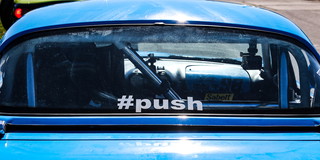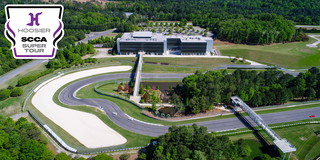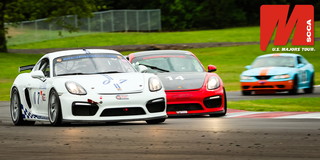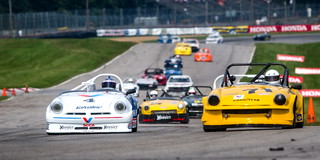
It may sound like an obvious statement, but races are much easier to win when you start from the front. Just ask any F1 driver who had to start from the second row at Monaco.
Because of this, everybody wants to be on the pole position, or at least P2. Unfortunately, the spots up front are limited. It turns out, earning the pole isn’t about luck (although luck does help) – it’s about preparation, having a game plan, and laying down a flyer when it counts (when the track is clear, the tires are optimized, and the weather is just right).
Here are five things to help you improve your qualifying position and push you to that coveted front row.
1. Have A Plan
There’s no plan like no plan.
I’ve seen plenty of drivers in the paddock look at the schedule and realize qualifying is in 10 minutes. They’ll grab their helmet, jump in their car (which they haven’t touched since the day before), and idle out to the grid for a 20-minute qualifying session. They’ll drive hard for the whole session and then come in having no idea what their starting position is until the grid sheets are posted for the race. That is the “no plan” method.
Instead of jumping in and hoping for the best, have a plan of attack.

(Having an organized gameplan for what will occur during qualifying and communicating that to your team is crucial for a successful session. Photo by Debbie Krider)
Know approximately what lap time is required to achieve the pole based on previous events in your class (what is the track record?). Then put yourself in a pre-grid position that will help you have a clear track for a fast lap. Set the car up to have a light fuel load for qualifying. Know the fast line for qualifying – a line you can’t necessarily run in traffic but can run for a quick solo lap. Know how much of the session you want to use based on tire temperature and fuel load. You shouldn’t need the whole 20-minute session; if things go to plan, you can pull off the track after seven minutes (saving tires, brakes, and gas). Get yourself mentally ready for the intensity of a single fast perfect lap, visualize your braking points, your shifting points, and staying smooth on the wheel.
If you want to be at the pointy end of the field, treat qualifying with the importance it deserves, and have a plan for success.
2. Fire The Tires
Tire management is important for a long race, but it’s equally important for qualifying.
Finding the exact temperature of the tires for maximum grip, before they get too hot and begin to feel greasy, is crucial to setting a lap that’s quicker than your competitors. Knowing how to properly heat the tires during a warm-up lap (sometimes called “firing the tires”) can help you have the perfect tire temperature for an early lap in the session.

(Having the perfect temperature in your tires at the right moment is everything during a qualifying session. Knowing how to reach that temperature is key to success.
Photo by Gorilla Tornado Photography)
We’ve all seen drivers zigging and zagging back and forth to put heat in the tires, but I’ve found the amount of friction (and friction = heat) acting on the tires as a driver weaves back and forth is nothing in comparison to the amount of friction the driver can get when threshold braking. I’ve found that by giving myself a lot of space on track (I don’t want to surprise anyone and get rearended on a warm-up lap) and then doing some heavy braking “fires the tires” much quicker. I’ll zig and zag back to feel if the rear tires are warm enough to keep me from spinning, but the real work is done during braking.
Regardless of how you choose to do it, the goal is to “fire the tires” early, get them to the perfect temperature, and then hit that one fast lap.
3. Spotter To Manage Traffic and Lap Times
A lot of teams use spotters with radios to keep the drivers out of trouble during a race, but I’ve noticed some teams don’t use their spotter during qualifying. For me, my spotter is even more important during qualifying.
The spotter can see the entire track where the driver cannot. This allows the team to manage track position when going for a flyer lap. There’s no point in running 80% of a perfect lap only to be held up in the final corner by a slower car. The spotter can help the driver slow down or speed up prior to approaching the start/finish to ensure the qualifying lap is on a clear track.

(A spotter, often referred to as eyes in the sky, or mirrors in your ear, is crucial during a qualifying session to help find clear track for the driver. Photo by Rob Krider)
The spotter can also watch the lap times of all of the competitors on their phone. This information is crucial because if the spotter can see you’ve already hit the lap you need to get the pole, you can call it a day and save the tires, brakes, gas, and engine for the race.
Finding clear track while many cars are on the course is probably one of the most frustrating things about qualifying, and a spotter (if you have one) can minimize a lot of that frustration by being your eyes in the sky.
4. Predictive Lap Timer
The technology, price, and ease of use of predictive lap timers have come a long way in the last decade. Not only do they tell you what your last lap was, some show green or red lights to indicate whether your current lap is faster or slower than your fastest lap of the session. This is immensely helpful because it can help you decide whether you should keep pushing or dial back on a lap.

(Information is key, and a predictive lap timer provides immensely important information real time during a qualifying session. Photo by Rob Krider)
If I have a moment early in a lap and I see the predictive lap timer has a lot of red lights on, indicating the lap is slow, I’m not naïve enough to think I can make it all up and go faster in the next corner; instead, I’ll slow to cool the tires for half a lap and then talk to my spotter about finding a good track position before I get to start/finish. Maybe I’ll even find a faster car I can draft behind to get a tow during the next lap.
Predictive lap timers let you know instantaneously if you’re going fast or slow. A word of caution, though: I’ve found the predictive lap timer also pushes you beyond the car’s ability (and often the driver’s ability) when you see a lot of green lights (indicating a faster lap). Heading into the final turn on a flier, you’ll be tempted to take that turn like a madman. Sometimes the grip isn’t there and you lose it all.
Qualifying is hard, folks.
5. Car Setup for a Short Session
A race might be 30 or 45 minutes; done right, qualifying might be as little as one hot lap. Because of this, setting up for qualifying is key.
Fuel load is one component – the less fuel on board, the lighter your car is and the faster you’ll go. Remember, one gallon of fuel is around seven pounds. Your shock settings can also be adjusted to make the car a little looser for a qualifying lap – consider going beyond what you’d be comfortable with for a long race while battling in traffic. The types of tire compound you use can even be different.

(Whether it's for qualifying or the race, never stop working on your car. Photo by Andy Howe)
The point is, set the car up for the one single fastest lap possible (and still make minimum weight after the session).
I see many drivers leave the car completely alone during a race weekend – they drive it in warm-up, qualifying, and the race with the same setup. The teams who are battling for the pole position may change alignment, tire pressures, shock settings, and weight just for the qualifying session.
Don’t be lazy about it; dial the car in for qualifying and then after, dial the car in for the race.

(If your goal is to spray champagne, collect trophies, and win championships, having a good qualifying session will make all of these things easier. Photo by Stefan Jackowniak)
The next time you’re at the racetrack and your qualifying session is approaching, think about these five things and how they can help move you up the starting grid, because it’s a lot easier to win the race when you start from the front.
Remember, there’s no champagne for fourth place.
About the author: Rob Krider is a national champion racer, the author of the novel Cadet Blues, and is the host of the Stories and Cocktails podcast.
Lead photo by Jon Krolewicz










